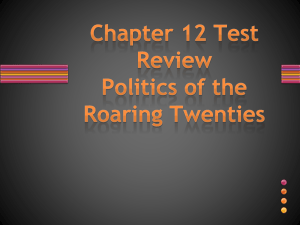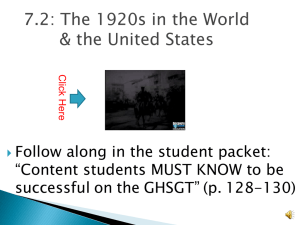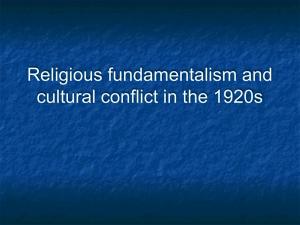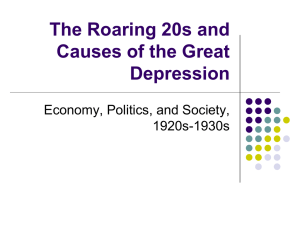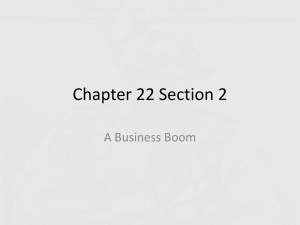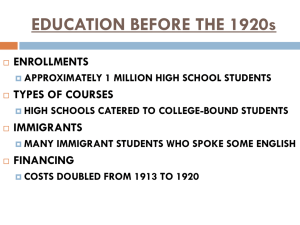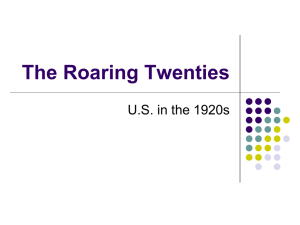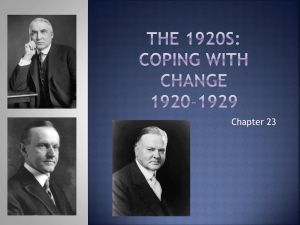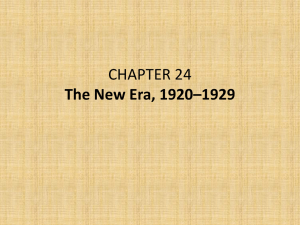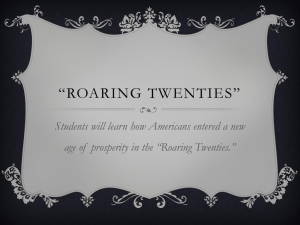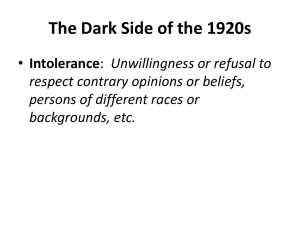1920`s Politics, Economics, and Entertainment
advertisement
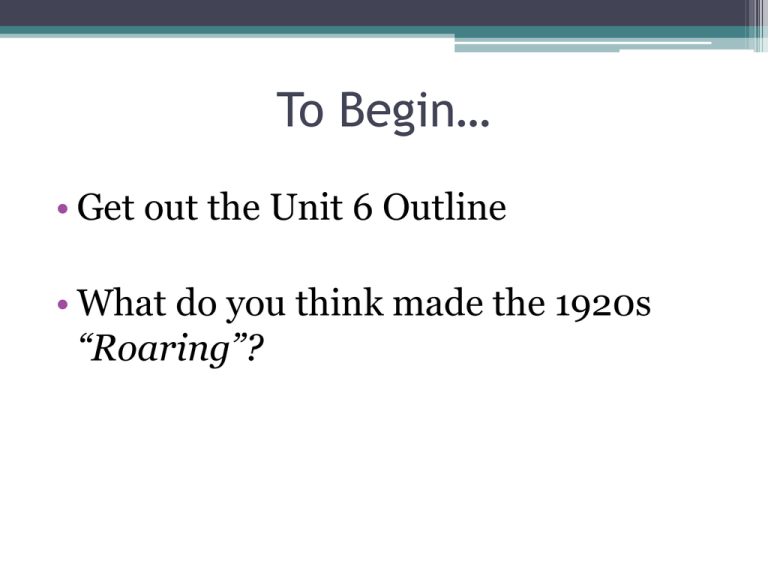
To Begin… • Get out the Unit 6 Outline • What do you think made the 1920s “Roaring”? Back to Normalcy: Politics and Economics of the 1920s To what degree are the 1920s a reaction to WW1? 2/7 “America's present need is not heroics, but healing; not nostrums, but normalcy; not revolution, but restoration; not agitation, but adjustment; not surgery, but serenity; not the dramatic, but the dispassionate; not experiment, but equipoise; not submergence in internationality, but sustainment in triumphant nationality.” -Warren G. Harding May 1920 Vanzetti PD • Discuss the Vanzetti PD with your neighbor. What stands out to you? What questions do you have? • In one box on the white board: ▫ What do you infer about the 1920s from this piece? ▫ How does the reading reveal the 1920s as a reaction to WW1? “I believe we should place them [the reds] on a ship of stone, with sails of lead, and that their first stopping place should be hell.” -Guy Empey Politics • Red Scare: ▫ Palmer Raids ▫ Sacco and Vanzetti • Nativism ▫ Quotas ▫ Ku Klux Klan • Isolationism ▫ Treaty of Versailles ▫ Disarmament ▫ High tariffs “Hit the Trail” PD • Discuss “Hit the Trail” with your neighbor. What stands out to you? What questions do you have? • In one box on the whiteboard: ▫ What do you infer about the 1920s from this piece? ▫ How does the reading reveal the 1920s as a reaction to WW1? “The chief business of America is business… the man who builds a factory builds a temple – the man who works there worships there.” - Calvin Coolidge Economics • Fiscal Policy ▫ Tax cuts ▫ Decreased regulation • Anti-Labor ▫ Association with Communism ▫ Boston Police Strike • Consumerism ▫ Innovation ▫ Credit ▫ Advertising 1920’s Music • After listening to the music samples, discuss them with your neighbor. What do you notice? • In one box on the whiteboard: ▫ What do you infer about the 1920s from these pieces? ▫ How does the music reveal the 1920s as a reaction to WW1? Entertainment • Mass Culture ▫ Movies ▫ Radio • A Mobile Society ▫ Automobiles ▫ Planes • Arts and Sports ▫ Baseball and boxing ▫ Feats of personal strength ▫ Jazz, literature Back to normal?? • Synthesizing the information provided by your peers (and your own ideas), in what ways were Americans in the 1920s trying to achieve normalcy? All of the following were notable trends and movements of the 1920s EXCEPT A. B. C. D. E. Increase in union membership Increase in productivity Urbanization Consumerism Business prosperity Which of the following best characterizes the differences between the post-Civil War and the post1915 versions of the Ku Klux Klan? A. The more modern version had less appeal among Americans due to a greater sense of tolerance among the population as a whole. B. The more modern version widened its focus to include virtually all groups that it perceived as violating “traditional” ideals and social norms. C. The more modern version had little appeal to women. D. The more modern version made little effort to venture beyond the Deep South. E. The more modern version sought to operate in secret to as great a degree as possible. Which of the following was the most significant factor in promoting American economic growth in the 1920s? A. Government policies that emphasized national planning and centralized control of the economy B. A wide variety of technological innovations that spurred growth in both production and consumption C. The increasing globalization of the American economy, encouraged by the government’s free-trade polices D. The increasingly even distribution of wealth, which led to balanced consumption by all groups in society E. The success of businesses and agricultural leaders in controlling production and thus avoiding conditions that had led to previous recessions Sacco and Vanzetti were A. Leaders of the prohibition movement B. Arrested and convicted for placing bombs on Wall Street C. Trade union leaders arrested by the government for organizing illegal strikes D. Anarchists who were controversially convicted and executed for murder E. Major League baseball players …To End: practice thesis • How did TWO of the following help to shape American national culture in the 1920s: advertising, mass production, entertainment?
